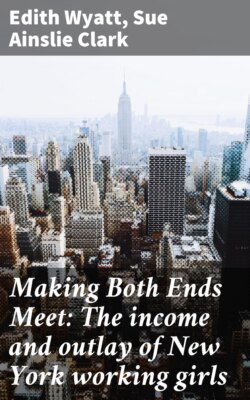Читать книгу Making Both Ends Meet: The income and outlay of New York working girls - Edith Wyatt - Страница 7
На сайте Литреса книга снята с продажи.
I
ОглавлениеTable of Contents
One of the most significant features of the common history of this generation is the fact that nearly six million women are now gainfully employed in this country. From time immemorial, women have, indeed, worked, so that it is not quite as if an entire sex, living at ease at home heretofore, had suddenly been thrown into an unwonted activity, as many quoters of the census seem to believe. For the domestic labor in which women have always engaged may be as severe and prolonged as commercial labor. But not until recently have women been employed in multitudes for wages, under many of the same conditions as men, irrespective of the fact that their powers are different by nature from those of men, and should, in reason, for themselves, for their children, and for every one, indeed, be conserved by different industrial regulations.
What, then, are the fortunes of some of these multitudes of women gainfully employed? What do they give in their work? What do they get from it? Clearly ascertained information on those points has been meagre.
About two years ago the National Consumers' League, through the initiative of its Secretary, Mrs. Florence Kelley, started an inquiry on the subject of the standard of living among self-supporting women workers in many fields, away from home in New York. Among these workers were saleswomen, waist-makers, hat makers, cloak finishers, textile workers in silk, hosiery, and carpets, tobacco workers, machine tenders, packers of candy, drugs, biscuits, and olives, laundry workers, hand embroiderers, milliners, and dressmakers.
The Consumers' League had printed for this purpose a series of questions arranged in two parts. The first part covered the character of each girl's work—the nature of her occupation, wages, hours, overtime work, overtime compensation, fines, and idleness. The second part of the questions dealt with the worker's expenses—her outlay for shelter, food, clothing, rest and recreation, and her effort to maintain her strength and energy. In this way the League's inquiry on income and outlay was so arranged as to ascertain, not only the worker's gain and expense in money, but, as far as possible, her gain and expense in health and vitality. The inquiry was conducted for a year and a half by Mrs. Sue Ainslie Clark.[1]
The account of the income and outlay of self-supporting women away from home in New York may be divided, for purposes of record, into the chronicles of saleswomen, shirt-waist makers, women workers whose industry involves tension, such as machine operatives, and women workers whose industry involves a considerable outlay of muscular strength, such as laundry workers.
Among these the narrative of the trade fortunes of some New York saleswomen is placed first. Mrs. Clark's inquiry concerning the income and outlay of saleswomen has been supplemented by portions of the records of another investigator for the League, Miss Marjorie Johnson, who worked in one of the department stores during the Christmas rush of 1909–1910.
Further informal reports made by the shop-girls in the early summer of 1910 proved that the income and expenditures of women workers in the stores had remained practically unchanged since the winter of Mrs. Clark's report.
So that it would seem that the budgets, records of the investigator, and statements given by the young women interviewed last June may be reasonably regarded as the most truthful composite photograph obtainable of the trade fortunes of the army of the New York department-store girls to-day.[2]
The limitations of such an inquiry are clear. The thousands of women employed in the New York department stores are of many kinds. From the point of view of describing personality and character, one might as intelligently make an inquiry among wives, with the intent of ascertaining typical wives. The trade and living conditions accurately stated in the industrial records obtained have undoubtedly, however, certain common features.
Among the fifty saleswomen's histories collected at random in stores of various grades, those that follow, with the statements modifying them, seem to express most clearly and fairly, in the order followed, these common features—low wages, casual employment, heavy required expense in laundry and dress, semidependence, uneven promotion, lack of training, absence of normal pleasure, long hours of standing, and an excess of seasonal work.
One of the first saleswomen who told the League her experience in her work was Lucy Cleaver, a young American woman of twenty-five, who had entered one of the New York department stores at the age of twenty, at a salary of $4.50 a week.
